Assert: Assert your viewpoint with intellectual honesty, using credible facts. Find possible areas of agreement on the topic.
Wonder: Consider who the other participant is. Are they a colleague, friend, family member? What is their viewpoint and why do they have it? How have their identity, socialization, and experience influenced their perspective?
Accept: Accept that you may not be able to change the other participant’s viewpoint and that yours might change. Acknowledge that this is an opportunity to share viewpoints rather than convince others you are correct. Remember, disagreement is okay and is part of civil discourse!
Respect: Respect the other participant. Do not use stereotypes, name‐calling, bias, or belittling to get your point across.
Establish: Establish outcomes and keep your conversation goal oriented. Be proactive if the discussion is escalating; move to a different topic. Reinforce that you and the other participant may still engage in conversation and maintain the present relationship.








